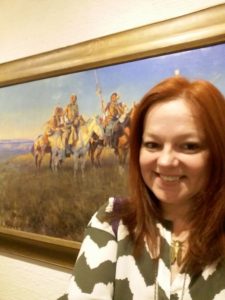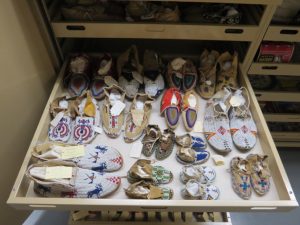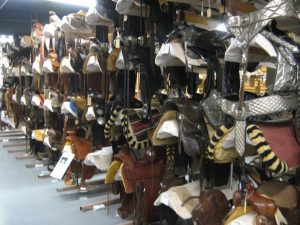by Natalie Kelsey

At the National Cowboy and Western Heritage Museum in Oklahoma City, OK, Tobie Cunningham works hard to bring the rich and complex history of the West to new visitors. But her start in the cultural heritage profession started, like many of us, with a passion for history. She was a college sophomore studying fashion merchandising, only taking history classes as a hobby, when a history professor pulled her aside and complimented her research and writing. She decided to change her major, and was drawn to museum studies and decided to try it out. It was a perfect match and Tobie found her calling.
After a hiatus from the profession to care for her chronically-ill child, Tobie’s current boss reached out to her. Although the open position, Associate Registrar for Collections and Exhibitions, was a slight step down in responsibility, Tobie chose to take the job. This was 9 years ago, and Tobie found that she enjoyed the position because it allowed her to get back to the things she loves most about the profession.
The museum was first known as the Cowboy Hall of Fame, and indeed this is the name many people still know it by. It was established as a way to honor notable cowboys – performers and rodeo stars as well as working cattlemen and ranchers. Tobie explains that this aspect is still active, and the Hall inducts members each year in “The Western Heritage Awards,” a key event for the museum. When the Hall of Fame first opened, attendance was high and people began to donate material related to the American West. From those materials, the museum developed. Today, the museum has a professional staff of about 60 people and counting security, maintenance, grounds- and housekeeping, the museum employs approximately 130 people.
Indigenous cultures are also represented in the museum’s collections. Although it can be difficult to integrate the stories of indigenous people and cowboy settlers, Tobie acknowledges that providing a complete history of the region means working with these often uncomfortable truths. Tobie also acknowledges the difficulty of reconciling the museum’s original mission with other stories – stories of the black cowboy, the paniolos of Canada, the gauchos of Mexico, and women in general. She explains that to exclude these stories would be to exclude a large part of their target audience – younger people who want to see themselves and others reflected in the museum’s collections. 
When I asked Tobie to tell me more about the National Cowboy and Western Heritage Museum, she said, “Ask your grandparents about it! They’ve probably heard of it!” This gets to the heart of the museum’s core demographic and, also, to the core of their outreach efforts. In order to bring in a younger audience, Tobie explains that the museum is now featured in ads on public radio and a local grassroots newspaper. They have also developed some new and different events that are geared more towards their target audience. Events like a monthly whiskey tasting and movie showings, free with the price of admission, have garnered a good response.These events generally draw about 50 people.
The newest event the museum offers is a summer camp for kids. The camp focuses on Western activities and children learn about life on the early Western frontier as well as the indigenous tribes of the area. Tobie says this takes full advantage of the museum’s resources to create a unique experience for the museum’s youngest patrons. Tobie’s own son participated in the first camp last summer and she said he and the other kids raved about the experience. Although the museum did not break even on the budget for the camp last summer, they are hoping that the great response will bring in more campers this summer. 
Although the museum faces funding challenges from the state, Tobie is hopeful that the future of the museum is bright. As new events bring in younger audiences, she hopes that it will free up time and funding to expand the museum’s collections.
